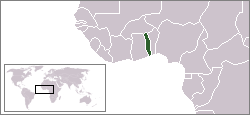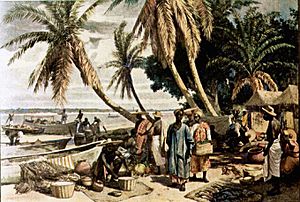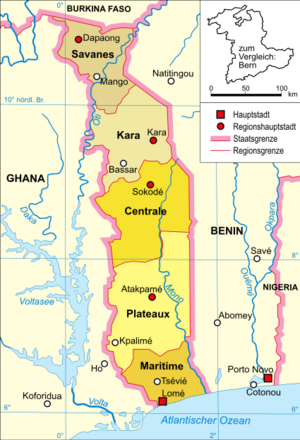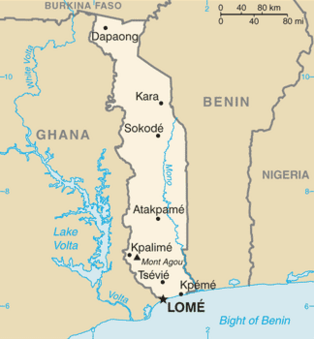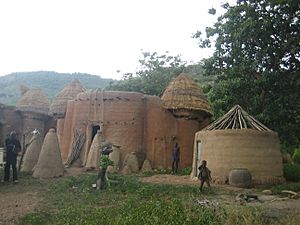Togo facts for kids
Quick facts for kids
Togolese Republic
République togolaise (French)
|
|
|---|---|
|
|
|
|
Motto: "Travail, Liberté, Patrie"
(English: "Work, Liberty, Homeland") |
|
|
Anthem: "Terre de nos aïeux"
(English: "Land of our ancestors") |
|
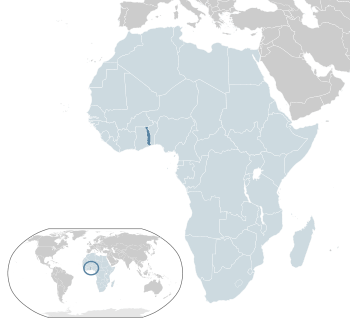
Location of Togo (dark blue)
in the African Union (light blue) |
|
| Capital and largest city
|
Lomé 6°8′N 1°13′E / 6.133°N 1.217°E |
| Official languages | French |
| Spoken languages | |
| Ethnic groups |
West African (94.4%)
Aja, Ewe and Mina (42.4%)
Kabye and Tem (25.9%) Akan and Gurma (17.1%) Kposo and Akebu (4.1%) Ana-Ife (3.2%) Other West African groups (1.7%) |
| Religion
(2020)
|
|
| Demonym(s) | Togolese |
| Government | Unitary presidential republic under a hereditary dictatorship |
| Faure Gnassingbé | |
| Victoire Tomegah Dogbé | |
| Legislature | National Assembly |
| Independence from Germany and France | |
|
• German Togoland
|
5 July 1884 |
|
• Togoland Campaign
|
6–26 August 1914 |
|
• French Togoland partitioned
|
27 December 1916 |
|
• Autonomy within the French Union
|
24 August 1956 |
|
• Independence granted from France
|
27 April 1960 |
| Area | |
|
• Total
|
56,785 km2 (21,925 sq mi) (123rd) |
|
• Water (%)
|
4.2 |
| Population | |
|
• 2024 estimate
|
|
|
• 2022 census
|
8,095,498 |
|
• Density
|
125.9/km2 (326.1/sq mi) (60th) |
| GDP (PPP) | 2023 estimate |
|
• Total
|
|
|
• Per capita
|
|
| GDP (nominal) | 2023 estimate |
|
• Total
|
|
|
• Per capita
|
$1,004 (170th) |
| Gini (2015) | ▼ 43.1 medium |
| HDI (2022) | low · 163rd |
| Currency | West African CFA franc (XOF) |
| Time zone | UTC (GMT) |
| Date format | dd/mm/yyyy |
| Driving side | right |
| Calling code | +228 |
| ISO 3166 code | TG |
| Internet TLD | .tg |
|
|
Togo is a small country in West Africa. It is bordered by Ghana to the west, Benin to the east and Burkina Faso to the north. The capital city Lomé is located along the Gulf of Guinea. In 2016, about 7.5 million people lived there. The official language is French. Togo was a hub of the Atlantic slave trade for Europeans. Togo was apart of the Slave Coast. Many Togolese descendants live in the Americas. The country is known for Voodoo. Togo is also known for it’s various flora and fauna. Monkeys, snakes, and lizards are numerous in many areas in Togo.
Contents
History
Archaeological finds indicate that tribes were able to produce pottery and process iron. The name Togo is translated from the Ewe language as "behind the river". During the period from the 11th century to the 16th century, tribes entered the region: the Ewé from the west, and the Mina and Gun from the east. Most of them settled in coastal areas. The Atlantic slave trade began in the 16th century, and for the next two hundred years the coastal region was a trading centre for Europeans in search of slaves, earning Togo and the surrounding region the name "The Slave Coast".
In 1884, a paper was signed at Togoville with King Mlapa III, whereby Germany claimed a protectorate over a stretch of territory along the coast and gradually extended its control inland. Its borders were defined after the capture of hinterland by German forces and signing agreements with France and Britain. In 1905, this became the German colony of Togoland. The local population was forced to work, cultivate cotton, coffee, and cocoa and pay taxes. A railway and the port of Lomé were built for export of agricultural products. The Germans introduced techniques of cultivation of cocoa, coffee and cotton and developed the infrastructure.
During the First World War, Togoland was invaded by Britain and France, proclaiming the Anglo-French condominium. The Togoland Campaign involved the successful French and British invasion of the German colony of Togoland during the West African Campaign of the First World War. Following the Allied invasion of the colony in August 1914, German forces were defeated, forcing the colony's surrender on 26 August 1914. On 7 December 1916, the condominium collapsed and Togoland was subsequently partitioned into British and French zones, creating the colonies of British Togoland and French Togoland. On 20 July 1922, Great Britain received the League of Nations mandate to govern the western part of Togo and France to govern the eastern part. In 1945, the country received the right to send three representatives to the French parliament.
After World War II, these mandates became UN Trust Territories. The residents of British Togoland voted to join the Gold Coast as part of the independent nation of Ghana in 1957. French Togoland became an autonomous republic within the French Union in 1959, while France retained the right to control defence, foreign relations, and finances.
Independence
The Togolese Republic was proclaimed on 27 April 1960. In the first presidential elections in 1961, Sylvanus Olympio became the first president, gaining 100% of the vote in elections boycotted by the opposition. On 9 April 1961, the Constitution of the Togolese Republic was adopted, according to which the supreme legislative body was the National Assembly of Togo.
Togo became the first African nation in to win an Olympic medal in canoeing at the 2008 Summer Olympics in Beijing when Benjamin Boukpeti won bronze in the K-1 slalom.
Togo joined the Commonwealth in June 2022.
Administrative divisions
Togo is divided into 5 regions which are subdivided in turn into 39 prefectures. From north to south the regions are Savanes, Kara, Centrale, Plateaux and Maritime.
Geography
It has an area equal to 56,785 km2 (21,925 sq mi). It borders the Bight of Benin in the south; Ghana lies to the west; Benin to the east; and to the north, it is bound by Burkina Faso. North of the equator, it lies mostly between latitudes 6° and 11°N, and longitudes 0° and 2°E.
The coast of Togo in the Gulf of Guinea is 56 km (35 miles) long and consists of lagoons with sandy beaches. In the north, the land is characterized by a rolling savanna in contrast to the centre of the country, which is characterized by hills. The south of Togo is characterized by a savanna and woodland plateau which reaches a coastal plain with lagoons and marshes. The highest mountain of the country is the Mont Agou at 986 metres (3235') above sea level. The longest river is the Mono River with a length of 400 km (250 miles). It runs from north to south.
The climate is "generally tropical" with average temperatures ranging from 23 °C (73 °F) on the coast to about 30 °C (86 °F) in the northernmost regions, with a drier climate and characteristics of a tropical savanna.
Togo contains three terrestrial ecoregions: Eastern Guinean forests, Guinean forest-savanna mosaic, and West Sudanian savanna. The coast of Togo is characterized by marshes and mangroves. The country had a 2019 Forest Landscape Integrity Index mean score of 5.88/10, ranking it 92nd globally out of 172 countries.
At least five parks and reserves have been established: Abdoulaye Faunal Reserve, Fazao Malfakassa National Park, Fosse aux Lions National Park, Koutammakou, and Kéran National Park.
Economy
The economy of this small African country is based on agriculture. Agriculture provides jobs for 65% of the labor force according to the CIA Factbook. Agricultural products include coffee, cocoa, cotton, yams, cassava (tapioca), corn, beans, rice, millet, and sorghum. Industries include phosphate mining, agricultural processing, cement, handicrafts, textiles, and beverages. Togo's economy is primarily agricultural.
Government

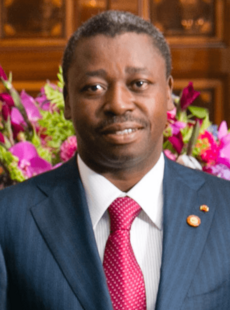
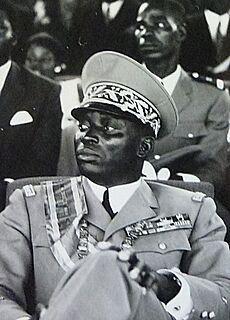
The president is elected by universal and direct suffrage for five years, and is the commander of the armed forces and has the right to initiate legislation and dissolve parliament. Executive power is exercised by the president and the government. The head of government is the Prime Minister who is appointed by the president.
Demographics
| Population | |||
|---|---|---|---|
| Year | Million | ||
| 1950 | 1.4 | ||
| 2000 | 5.0 | ||
| 2018 | 7.9 | ||
The November 2010 census gave Togo a population of 6,191,155, more than double the total counted in the last census; in 2022 the Togo population was 8,680,832. That census, taken in 1981, showed the nation had a population of 2,719,567. The capital, Lomé, grew from 375,499 in 1981 to 837,437 in 2010. When the urban population of surrounding Golfe prefecture is added, the Lomé Agglomeration contained 1,477,660 residents in 2010.
Other cities in Togo according to the new census were Sokodé (95,070), Kara (94,878), Kpalimé (75,084), Atakpamé (69,261), Dapaong (58,071) and Tsévié (54,474). With an estimated population of 7,889,093 (as of 2018[update]), Togo is the 107th largest country by population. Most of the population (65%) live in rural villages dedicated to agriculture or pastures. The population of Togo shows a stronger growth: from 1961 (the year after independence) to 2003 it quintupled.
|
Largest cities or towns in Togo
According to the 2010 Census |
||
|---|---|---|
| Rank | Name | Pop. |
| 1 | Lomé | 1,477,658 |
| 2 | Sokodé | 117,811 |
| 3 | Kara | 94,878 |
| 4 | Kpalimé | 75,084 |
| 5 | Atakpamé | 69,261 |
| 6 | Dapaong | 58,071 |
| 7 | Tsévié | 54,474 |
| 8 | Anié | 37,398 |
| 9 | Notsé | 35,039 |
| 10 | Cinkassé | 26,926 |
Economy
The country possesses phosphate deposits and an export sector based on agricultural products such as coffee, cocoa bean, and peanuts (groundnuts), which together generate roughly 30% of export earnings. Cotton is a cash crop. The fertile land occupies 11.3% of the country, most of which is developed. Some crops are cassava, jasmine rice, maize and millet. Some other sectors are brewery and the textile industry. Low market prices for Togo's major export commodities coupled with the volatile political situation of the 1990s and 2000s had a negative effect on the economy.
It is listed in the least developed country group. It serves as a regional commercial and trade centre. The government's decade-long efforts supported by the World Bank and the International Monetary Fund (IMF) to carry out economic reforms, to encourage investments, and to create the balance between income and consumption has stalled. Political unrest, including private and public sector strikes throughout 1992 and 1993, jeopardized the reform program, shrank the tax base, and disrupted economic activities in the country. Togo was ranked 117th in the Global Innovation Index in 2024.
It imports machinery, equipment, petroleum products, and food. Its main import partners are France (21.1%), the Netherlands (12.1%), Côte d'Ivoire (5.9%), Germany (4.6%), Italy (4.4%), South Africa (4.3%) and China (4.1%). The main exports are cocoa, coffee, re-export of goods, phosphates and cotton. "Major export partners" are Burkina Faso (16.6%), China (15.4%), the Netherlands (13%), Benin (9.6%) and Mali (7.4%).
In terms of structural reforms, it has made progress in the liberalization of the economy, namely in the fields of trade and port activities. The privatization program of the cotton sector, telecommunications and water supply has stalled.
On 12 January 1994, the devaluation of the currency by 50% provided an impetus to renewed structural adjustment; these efforts were facilitated by the end of strife in 1994 and a return to overt political calm. Progress depends on increased openness in government financial operations (to accommodate increased social service outlays) and possible downsizing of the armed forces, on which the regime has depended to stay in place. Lack of aid and depressed cocoa prices generated a 1% fall in GDP in 1998, with growth resuming in 1999. Togo is a member of the Organization for the Harmonization of Business Law in Africa (OHADA).
Agriculture is the "backbone" of the economy. A shortage of funds for the purchase of irrigation equipment and fertilizers has reduced agricultural output. Agriculture generated 28.2% of GDP in 2012 and employed 49% of the working population in 2010. The country is essentially self-sufficient in food production. Livestock production is dominated by cattle breeding.
Mining generated about 33.9% of GDP in 2012 and employed 12% of the population in 2010. Togo has the fourth-largest phosphate deposits in the world. Their production is 2.1 million tons per year. There are reserves of limestone, marble and salt. Industry provides 20.4% of Togo's national income, as it consists of light industries and builders. Some reserves of limestone allows Togo to produce cement.
Religion
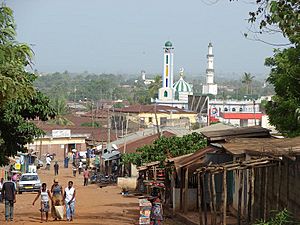
About 51% of the population has local beliefs, 29% is Christian, and 20% Muslim.
Languages
According to Ethnologue, 39 distinct languages are spoken in the country, some of them by communities that number fewer than 100,000 members. Of the 39 languages, the sole official language is French. Two spoken indigenous languages were designated politically as national languages in 1975: Ewé (Ewe: Èʋegbe; French: Evé) and Kabiyé.
Though not native to most groups, French is used in formal education, legislature, all forms of media, administration and commerce.
Culture
The culture reflects the influences of ethnic groups, the largest of which are the Ewe, Mina, Tem, Tchamba and Kabre. Some people follow native animistic practices and beliefs.
Ewe statuary is characterized by its statuettes which illustrate the worship of the ibeji. Sculptures and hunting trophies were used rather than the "more ubiquitous" African masks. The wood-carvers of Kloto has their "chains of marriage": Two characters are connected by rings whittled from one piece of wood.
The dyed fabric batiks of the artisanal centre of Kloto represent stylized and coloured scenes of ancient everyday life. There are loincloths used in the ceremonies of the weavers of Assahoun. Works of the painter Sokey Edorh are inspired by the "immense arid extents, swept by the dry wind", and where the soil keeps the prints of the men and the animals. The plastics technician Paul Ahyi practiced the "zota", a kind of pyroengraving, and his monumental achievements decorate Lomé.
Basketball is Togo's "second most practiced sport". Togo featured a national team in beach volleyball that competed at the 2018–2020 CAVB Beach Volleyball Continental Cup in the men's section.
Mass media in Togo includes radio, television, and online and print formats. The Agence Togolaise de Presse news agency began in 1975. The Union des Journalistes Independants du Togo press association is headquartered in Lomé.Togolese Television is the state-owned service.
Related pages
Images for kids
-
Women in Sokodé.
-
Footballer Emmanuel Adebayor.
See also
 In Spanish: Togo para niños
In Spanish: Togo para niños




